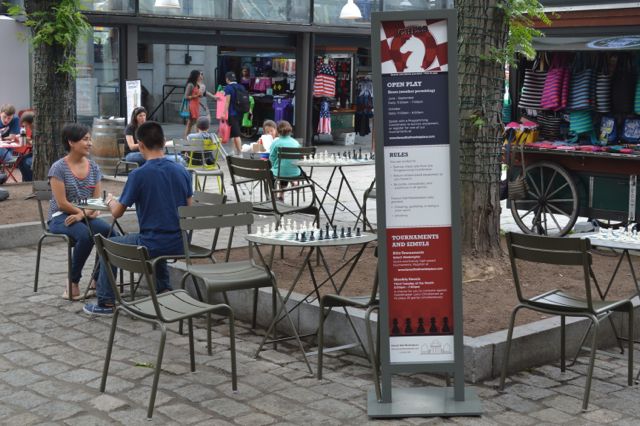
As the City of Boston continues to push forward with the process to redesign City Hall Plaza, it seems taking a minimalist approach might be the most effective. Having recently added more than 40 plastic Adirondack-style chairs, with accompanying tables so soon follow, City Hall Plaza is already redefined and is quickly being distanced from its former reputation as a brick wasteland.
Activating a public space like this doesn’t necessarily require a complete overhaul. Sure, it’d be great to see the plaza torn up and refurbished with ample greenery, a designated spot for event programming and a section dedicated to some kind of hospitality feature like a bar or rendezvous spot for food trucks. But even the simple addition of basic furniture can bring the placemaking process to a more engaging level.
Proof of this can be seen inside the concrete walls of City Hall but also in some of Boston’s other outdoor destinations such as the Rose Kennedy Greenway, Faneuil Hall Marketplace, and The Lawn on D.
Furniture affords passersby a place to congregate. Inside City Hall, on the third floor mezzanine, tables and chairs have transformed what’s historically been a cavernous foyer into a place to meet acquaintances, read a book, take lunch or simply escape the rigors of the daily grind if only for a matter of minutes.

With an added vibrancy provided courtesy of the Stairs of Fabulousness and rotating art displays, the mezzanine exemplifies how simplicity can equal significance when it comes to stimulating a space.
The same holds true for parks. The Rose Kennedy Greenway welcomed the addition of several hammocks shortly after hoisting its beautiful As If It Were Already Here aerial sculpture above its Fort Point Channel Parks. Along with the standalone chairs on that section of the park, the Greenway was able to provide seating for people to enjoy the park and its art rather comfortably.
“We viewed the hammocks as a perfect complement to the atmosphere of our Fort Point Channel Park while also providing another unique viewing experience for the monumental piece of public art above,” said Greenway Conservancy Executive Director Jesse Brackenbury. “It is almost not possible to walk by the park – day or night – and see the hammocks empty. Bostonians and visitors alike fill the hammocks each day to rest, relax, and enjoy the Greenway’s organic horticulture and contemporary public art.”
And it’s not solely about comfort. At Faneuil Hall Marketplace outdoor pool tables, ping ping tables, chess boards and board games enhance the public experience in a more interactive way. It creates a new dimension for a location known primarily for retail without any added overkill.
“The new programming elements are ideal for all ages, and also include things like art lessons, fitness classes, pool, and ping pong, as well as history tours and literary talks,” said Dan Biederman, founder of Biederman Redevelopment Ventures which undertook the marketplace’s enhancement. “Simple things like moveable chairs and tables can transform a public space, and increase the sense of excitement about visiting adjacent retail opportunities.”
Designers and placemakers, though, aren’t adding items to spaces simply because they can. Rather, these days they’re utilizing public space in a way that mirrors the surging sharing economy.
As evidenced by the rise of car-, ride- and bike-share apps and startups, as well as micro-living that fosters where the draw is shared community areas as opposed to larger private residences, the millennial generation places a greater emphasis on inclusivity than generations past.

“This has to do with broader demographic and cultural shifts,”said Philip Barash, creative director of local design firm Sasaki Associates. “Our parents’ generation, roughly speaking, valued things like privacy and family and having their own space. We value things like community and a sense of tribe.”
Valuing allows for more public expression on the part of the passerby, and the public space acts as the catalyst for this.
“Having places for people to relax and linger and gather are all pieces of the toolkit we’ve been using forever,” added Nina Chase, a landscape architect at Sasaki.
As is the case with the Massachusetts Convention Center Authority’s popular park The Lawn on D, the idea of relaxing, lingering and gathering can successfully take place in the form of a more audacious playfulness than a suburban backyard barbecue.
“Play is now acceptable again in public spaces,” added Chase. “It’s fun. And we’re excited about injecting fun into Boston.”
Certainly furniture and other basic features to an open space can certainly attract more people but it’s cyclical. People increasingly want to converge in groups to take advantage of all the public amenities afforded to them. In turn, municipalities or various other overseeing bodies are motivated to provide means for residents and visitors to congregate in a more enjoyable fashion.
“You don’t always need food, coffee and a bar to activate public space – although it helps” said Haril Pandya, principal at CBT Architects. “People inherently want to gather, talk and interact, especially in a causal and relaxed environment. Adding tables and chairs to a place like City Hall Plaza or on rooftops or on front entries of corporate buildings are instant gathering and interaction moments.”

